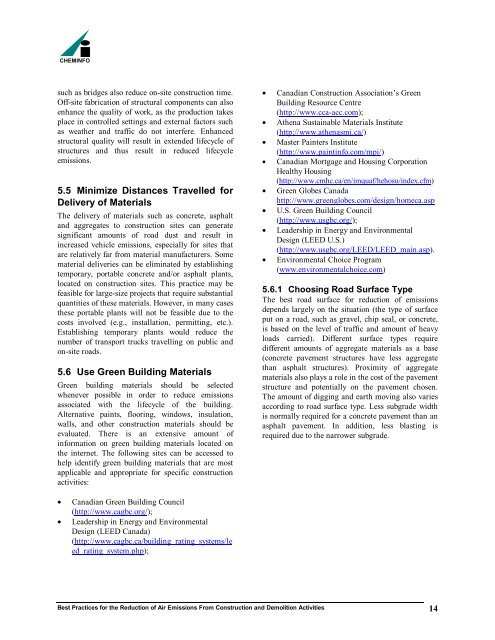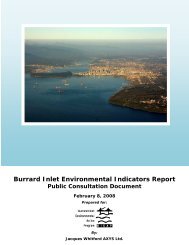Best Practices for the Reduction of Air Emissions From Construction ...
Best Practices for the Reduction of Air Emissions From Construction ...
Best Practices for the Reduction of Air Emissions From Construction ...
You also want an ePaper? Increase the reach of your titles
YUMPU automatically turns print PDFs into web optimized ePapers that Google loves.
CHEMINFO<br />
such as bridges also reduce on-site construction time.<br />
Off-site fabrication <strong>of</strong> structural components can also<br />
enhance <strong>the</strong> quality <strong>of</strong> work, as <strong>the</strong> production takes<br />
place in controlled settings and external factors such<br />
as wea<strong>the</strong>r and traffic do not interfere. Enhanced<br />
structural quality will result in extended lifecycle <strong>of</strong><br />
structures and thus result in reduced lifecycle<br />
emissions.<br />
5.5 Minimize Distances Travelled <strong>for</strong><br />
Delivery <strong>of</strong> Materials<br />
The delivery <strong>of</strong> materials such as concrete, asphalt<br />
and aggregates to construction sites can generate<br />
significant amounts <strong>of</strong> road dust and result in<br />
increased vehicle emissions, especially <strong>for</strong> sites that<br />
are relatively far from material manufacturers. Some<br />
material deliveries can be eliminated by establishing<br />
temporary, portable concrete and/or asphalt plants,<br />
located on construction sites. This practice may be<br />
feasible <strong>for</strong> large-size projects that require substantial<br />
quantities <strong>of</strong> <strong>the</strong>se materials. However, in many cases<br />
<strong>the</strong>se portable plants will not be feasible due to <strong>the</strong><br />
costs involved (e.g., installation, permitting, etc.).<br />
Establishing temporary plants would reduce <strong>the</strong><br />
number <strong>of</strong> transport trucks travelling on public and<br />
on-site roads.<br />
5.6 Use Green Building Materials<br />
Green building materials should be selected<br />
whenever possible in order to reduce emissions<br />
associated with <strong>the</strong> lifecycle <strong>of</strong> <strong>the</strong> building.<br />
Alternative paints, flooring, windows, insulation,<br />
walls, and o<strong>the</strong>r construction materials should be<br />
evaluated. There is an extensive amount <strong>of</strong><br />
in<strong>for</strong>mation on green building materials located on<br />
<strong>the</strong> internet. The following sites can be accessed to<br />
help identify green building materials that are most<br />
applicable and appropriate <strong>for</strong> specific construction<br />
activities:<br />
• Canadian Green Building Council<br />
(http://www.cagbc.org/);<br />
• Leadership in Energy and Environmental<br />
Design (LEED Canada)<br />
(http://www.cagbc.ca/building_rating_systems/le<br />
ed_rating_system.php);<br />
• Canadian <strong>Construction</strong> Association’s Green<br />
Building Resource Centre<br />
(http://www.cca-acc.com);<br />
• A<strong>the</strong>na Sustainable Materials Institute<br />
(http://www.a<strong>the</strong>nasmi.ca/)<br />
• Master Painters Institute<br />
(http://www.paintinfo.com/mpi/)<br />
• Canadian Mortgage and Housing Corporation<br />
Healthy Housing<br />
(http://www.cmhc.ca/en/imquaf/hehosu/index.cfm)<br />
• Green Globes Canada<br />
http://www.greenglobes.com/design/homeca.asp<br />
• U.S. Green Building Council<br />
(http://www.usgbc.org/);<br />
• Leadership in Energy and Environmental<br />
Design (LEED U.S.)<br />
(http://www.usgbc.org/LEED/LEED_main.asp).<br />
• Environmental Choice Program<br />
(www.environmentalchoice.com)<br />
5.6.1 Choosing Road Surface Type<br />
The best road surface <strong>for</strong> reduction <strong>of</strong> emissions<br />
depends largely on <strong>the</strong> situation (<strong>the</strong> type <strong>of</strong> surface<br />
put on a road, such as gravel, chip seal, or concrete,<br />
is based on <strong>the</strong> level <strong>of</strong> traffic and amount <strong>of</strong> heavy<br />
loads carried). Different surface types require<br />
different amounts <strong>of</strong> aggregate materials as a base<br />
(concrete pavement structures have less aggregate<br />
than asphalt structures). Proximity <strong>of</strong> aggregate<br />
materials also plays a role in <strong>the</strong> cost <strong>of</strong> <strong>the</strong> pavement<br />
structure and potentially on <strong>the</strong> pavement chosen.<br />
The amount <strong>of</strong> digging and earth moving also varies<br />
according to road surface type. Less subgrade width<br />
is normally required <strong>for</strong> a concrete pavement than an<br />
asphalt pavement. In addition, less blasting is<br />
required due to <strong>the</strong> narrower subgrade.<br />
<strong>Best</strong> <strong>Practices</strong> <strong>for</strong> <strong>the</strong> <strong>Reduction</strong> <strong>of</strong> <strong>Air</strong> <strong>Emissions</strong> <strong>From</strong> <strong>Construction</strong> and Demolition Activities 14
















